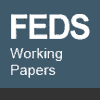
| Finance and Economics Discussion Series |
|---|
 |
The Extreme Bounds of the Cross-Section of Expected Stock Returns J. Benson Durham 2002-34 |
Abstract: Several empirical studies report violations of the asset-pricing model
of Sharpe (1964), Lintner (1965), and Black (1972). But, there is no consensus
on specification in this literature, as such studies typically consider only a
limited number of explanatory variables and do not satisfactorily control for
previous findings. Extreme bound analysis (EBA), an imperfect but useful remedy
for model uncertainty, suggests that comparatively few factors are robust.
Given the cross-section of expected stock returns from July 1963 through December
2000, three of 23 variables - market size as well as short and medium run lagged
return - pass the traditional EBA decision rule given all possible 3-, 4-, and
5-factor models of monthly stock returns. This paper also explores several
potential improvements to EBA, including explicit consideration of possible
multicollinearity, which largely does not affect the results, as well as sample
divisions, which suggest that fewer variables are sturdy correlates
of returns.
Home | FEDS | List of 2002 FEDS papers
Accessibility
To comment on this site, please fill out our feedback form.
Last update: August 14, 2002